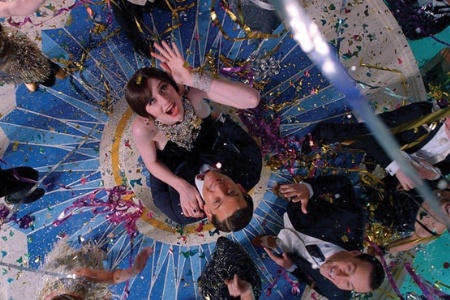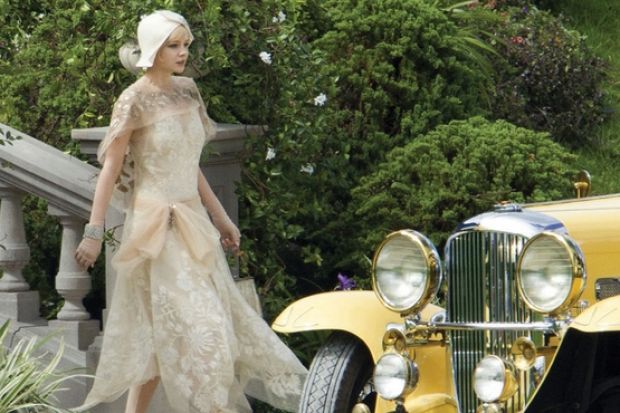The Great Gatsby
Directed by Baz Luhrmann
Starring Leonardo DiCaprio and Carey Mulligan
On general release
Careless People: Murder, Mayhem and the Invention of The Great Gatsby
By Sarah Churchwell
Virago, 448pp, £16.99
ISBN 9781844087662
Published 6 June 2013
The ballyhooed and much anticipated Baz Luhrmann version of The Great Gatsby is in 3D - as if there weren’t already enough dimensions to this oft-revisited tale. But this latest screen incarnation, accompanied by a juggernaut of a publicity machine, is surely something F. Scott Fitzgerald would have simultaneously scoffed at and embraced. The first film of his powerfully plotted novel, released in 1926, was so poor that Scott and Zelda Fitzgerald walked out of a screening, proclaiming it rotten. One wonders what the author’s reaction would be to this version on steroids - when Jazz Age retro meets Digital Age repo. He would most likely be thrilled by the party scenes but have his own notes for delivery of one of the finest lines in American literature: “Her voice is full of money.”
Why and how certain stories provide inspiration over and over again is the stuff not just that dreams are made of but the very marrow of literary iconography. The Great Gatsby, two years shy of its 90th birthday, is still going strong and facing up to ever-evolving interpretations. Whereas the Gatsby of the 1920s seemed out of step with his pronouncements about repeating the past, why wouldn’t today’s generation, raised on instant replay, believe you can always repeat the past?
Sarah Churchwell’s imaginative Careless People: Murder, Mayhem and the Invention of The Great Gatsby, soon to be published, struggles to incorporate not only the significance of the book but the creative process that went into this masterpiece. She also provides a rich back story on Scott and Zelda, surely the most iconic American couple.
For months, culture vultures have been giddy, awaiting the premiere of this Luhrmann project - with intermittently released trailers building anticipation, whetting consumer appetites. It would be small-minded to label Luhrmann’s artistic investment a mere film, as some tie-ins demonstrate pulsating brilliance: the lavish Fitzgerald suite at the New York Plaza (a little over $2,700 per night), say, or tiaras and other accessories (a yellow and white diamond daisy brooch) available from Tiffany’s as part of the Great Gatsby Collection. This seems courtesy of superior marketeering by the director’s wife and collaborator, Catherine Martin. The couple’s look and feel for the film are a part of its aesthetic entrapment - how can you not go to see it, silly glasses and all, after such razzle-dazzle has gone into it?
In true Fitzgerald tradition, a failure could reverse into success - as was the case for Gatsby, which achieved immortality for its author only after his death in 1940.
In the 21st century, Gatsby has inspired at least one ballet, one musical, a made-for-television adaptation, a hip-hop African American “loosely based on” adaptation and Fitzgerald appears briefly as a character in Woody Allen’s Midnight in Paris (2011). But the most remarkable tribute is Gatz, a performance of the c.50,000-word text that last year wowed audiences in Manhattan and London despite lasting six hours. I found the enthusiasm of London’s theatre crowd particularly heartening, as the mostly young audience seemed to lean into every syllable of the imaginative staging by the Elevator Repair Service. Yet the most inspirational of all is this fourth cinematic incarnation. (A silent version is lost, Alan Ladd’s performance in the 1949 version needs to get lost and the 1974 version is available on Netflix.)
Luhrmann’s new film has been compared frequently to Jack Clayton’s Robert Redford-Mia Farrow vehicle of 1974. Carey Mulligan (Daisy Buchanan) and Leonardo DiCaprio (Jay Gatsby) take on this star turn with excellent results. DiCaprio has a ridiculous accent (of course he does, because Gatsby does) and Mulligan doesn’t really measure up. But again, that’s the point: no one can live up to Gatsby-Fitzgerald’s idealisation of the unattainable.
Fitzgerald hard cases will be oblivious to the film’s good points and busy ridiculing it, yet they need to realise that, however flawed, it will boost appreciation of the 1920s, flappers, Prohibition and, most of all, the book that started it all.
The Great Gatsby sold roughly 10,000 copies when it appeared in 1925 but by the following year it had become a commercial and critical flop. It was during the Second World War that it took off, with enlisted men turning the book into a cult favourite (more than 150,000 copies were given away to soldiers, as opposed to the fewer than 25,000 sold in the previous decades). The Great Gatsby became a classic within a generation and now regularly sells half a million copies a year.

Shortly after completing his manuscript, Fitzgerald confessed to editor Maxwell Perkins: “I think my novel is about the best American novel ever written.” Although T.S. Eliot, Edith Wharton and Gertrude Stein generously weighed in with praise, Fitzgerald famously complained that critics who wrote positively about his masterpiece did not understand it - and his disappointment marked the beginning of a series of literary mortifications. When the Modern Library withdrew the volume because of poor sales, after alcohol and dissipation had taken their debilitating toll, Fitzgerald bemoaned his decline to Zelda, “My God, I am a forgotten man…”
The Fitzgeralds kept elaborate scrapbooks of every notice and mention, but Churchwell has to reconstruct what papers these mentions came from, which clearly required a good deal of legwork. Yet the book, like the green light at the end of Daisy’s dock, keeps us pulled in.
Churchwell’s fascination with her fellow Princetonian and his wife has resulted in an extremely complex re-rendering of the world according to Fitzgerald, but with delicious analysis all Churchwell’s own. The early chapters are charmingly animated around thematic topics. She has produced one of those absorbing books where fascinating facts pop up on every page. What was the speed limit for cars after they left Manhattan? (30mph). Which of the Fitzgeralds said “plagiarism begins at home”? (Yes, Zelda…). When did the term “gatecrashing” appear in American slang? (1922). Where did Fitzgerald take his gang late at night for some necro-tourism? (the City Morgue). Churchwell’s fascination with the era is clear, and her painstaking cross-checking of available data will assist scholars with important insights as she trains a spotlight on the novel’s Long Island setting of Great Neck/West Egg, Manhattan nightlife, alcohol and the clubbing spots that bewitched the author. A cast of characters from Einstein and the sister of the actress Marion Davies to writer Ring Lardner and French aviators appear in her pages. She successfully portrays a glittering era with subdued yet vibrant language: “Filaments of fact and fiction shed different lights on each other, and also throw shadows back on us.”
Long after the Luhrmann film is gone from the metroplexes and award ceremonies, long after Young and Beautiful has faded from the pop charts, I predict that Churchwell’s engaging book cover (with tuxedo-clad skeletons playing sax, picking up on Herb Roth’s “suggested bookplate” for Fitzgerald published in The New Yorker in 1925) will lure new generations of readers to appreciate one of the great creations of American literature - and the stories of the author who invented both himself and this unparalleled 20th-century saga.
Register to continue
Why register?
- Registration is free and only takes a moment
- Once registered, you can read 3 articles a month
- Sign up for our newsletter
Subscribe
Or subscribe for unlimited access to:
- Unlimited access to news, views, insights & reviews
- Digital editions
- Digital access to THE’s university and college rankings analysis
Already registered or a current subscriber?
